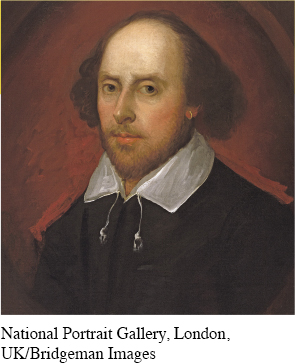6.1 CENTRAL TEXT
254
The Tragedy of Macbeth
William Shakespeare

William Shakespeare (1564–
KEY CONTEXT Written around 1606, Macbeth is loosely based on the life of the historical king Mac Bethed who reigned in Scotland from 1040 to 1057. The real Macbeth killed his predecessor Duncan I, and was in turn killed by Duncan’s son Malcolm III. Events such as these were not uncommon in the feudal Scotland of the eleventh century; of the fourteen kings who reigned between 943 and 1097, ten were murdered. However, the Scottish king bears very little resemblance to the character in Shakespeare’s play. Shakespeare was a playwright, after all, and driven by very different goals than a historian.
One of those goals was writing a play that Shakespeare’s patron, the newly crowned King James I, would enjoy. King James I had ascended to the throne in England in 1603, and Shakespeare began writing Macbeth soon after. King James I came from the same families who led to the real Macbeth’s downfall, and Shakespeare’s play acknowledges this fact and even flatters the man who had recently become the king of England. It was also well known that King James I was fascinated with witchcraft, even writing a book on demonology, which is probably why witches play a mysterious and important role in this play.
Dramatis Personae
DUNCAN King of Scotland

MACBETH Thane of Glamis, later of Cawdor, later King of Scotland

LADY MACBETH
BANQUO a thane of Scotland
FLEANCE his son
MACDUFF Thane of Fife
LADY MACDUFF
SON of Macduff and Lady Macduff
255
SIWARD Earl of Northumberland
YOUNG SIWARD his son
SEYTON an officer attending Macbeth
Another LORD
ENGLISH DOCTOR
SCOTTISH DOCTOR
GENTLEWOMAN attending Lady Macbeth
CAPTAIN serving Duncan
PORTER
OLD MAN
Three MURDERERS of Banquo
FIRST MURDERER at Macduff’s castle
MESSENGER to Lady Macbeth
MESSENGER to Lady Macduff
SERVANT to Macbeth
SERVANT to Lady Macbeth
Three WITCHES or WEIRD SISTERS
HECATE
Three APPARITIONS
Lords, Gentlemen, Officers, Soldiers, Murderers, and Attendants